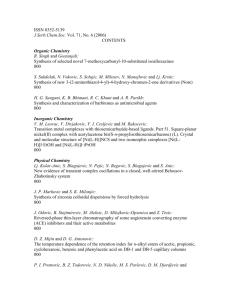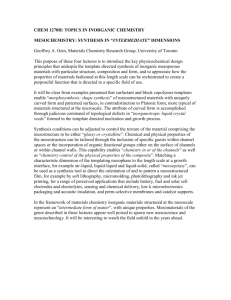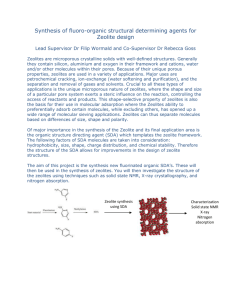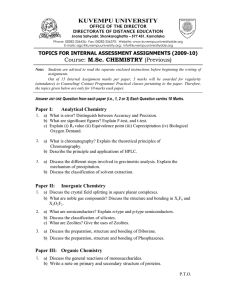4. Advanced features DP and structural disorder I
advertisement
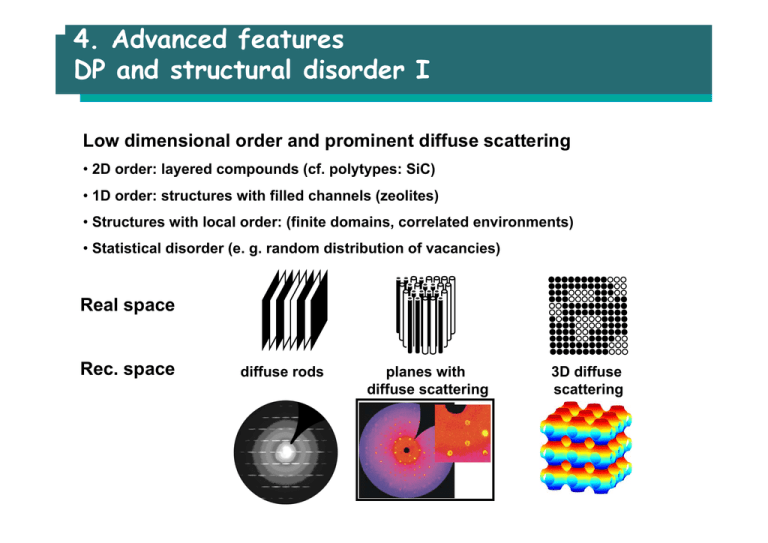
4. Advanced features DP and structural disorder I Low dimensional order and prominent diffuse scattering • 2D order: layered compounds (cf. polytypes: SiC) • 1D order: structures with filled channels (zeolites) • Structures with local order: (finite domains, correlated environments) • Statistical disorder (e. g. random distribution of vacancies) Real space Rec. space diffuse rods planes with diffuse scattering 3D diffuse scattering 4. Advanced features DP and structural disorder II Crystal data Formula sum Crystal system Space group Unit cell dimensions Z Cu0.8 In2.4 Se4 tetragonal I -4 2 m (no. 121) a = 5.7539(3) Å c = 11.519(1) Å 2 Atomic coordinates Atom Cu1 In1 In2 Se1 Ox. +1 +3 +3 -2 Wyck. 2a 4d 2b 8i Occ. 0.8 1.0 0.4 1.0 x 0 0 0 1/4 y 0 1/2 0 1/4 z 0 1/4 1/2 1/8 • Average structure • Random arrangement of vacancies: no prominent diffuse scattering 4. Advanced features Average vs. real structure Structure determination = X-ray diffraction = average of all different sections of a crystal typical section ordered crystal all sites fully occupied typical sections disordered crystal atoms and vacancies on one site Disordered crystal billions of different sections • X-ray diffraction (standard procedure): average of the structure • Consequence 1: a fraction of vacancies is on every site of the unit cell • Consequence 2: reduced occupancy factor • Consequence 3: average structures are not unambiguous 4. Advanced features Example for an average structure I Example: La2O3 (A-Form) Pauling, 1929; Schiller, 1985 La O Müller-Buschbaum, 1965 4. Advanced features Example for an average structure II 1D order: planes of diffuse intensity Average structure: split position of In, occ(In) = 0.5 c* b* In Se a* Real structure: superposition of two components, occ(In) = 1 Synthesis of solids 1. High temperature synthesis 2. Chemical vapour transport 3. Soft chemistry 4. Nanomaterials Introduction Goals of synthesis / preparation • Synthesis of new compounds • Synthesis of highly pure, but known compounds • Synthesis of highly pure single crystals (Iceberg-principle) • Structural modification of known compounds bulk-structures and nanostructures 2 nm 1. High temperature synthesis Classical solid state reaction from the elements Standard procedure: “Shake and bake”, “heat and beat”, “trial and error” “The starting materials are finely grinded, pressed to a pellet and heated to a temperature „near“ the melting temperature.” Parameters influencing the reaction: • Purity of educts (sublimation) • Handling of educts (glove box, Schlenck technique) • Temperature: T(reaction) > 2/3 T(melting point), rule of Tamann. Effects on real structure (more defects at elevated T) and diffusion (increase with T) • Solid state reactions are exothermic, “thermodynamically controlled“: Consequence: No metastable products (see e.g. Zeolites) • Porosity, grain size distribution and contact planes: High reactivity of nanoparticles / colloides (low CN) 1. High temperature synthesis Classical solid state reaction from the elements Experimental consequences: (1) large contact areas (2) small path lengths (3) small pore volume Reactive sintering: pellets of fine powders Problems / Pitfalls: • “Chemical problems” of containers materials: use of reactive materials remedy: double / coated containers • “Physical problems” of containers: compatible expansion/compression coefficients, sufficiently stable to withstand pressure • Separation of educts, remedy: special furnaces, reduced free volume, tricks • No intrinsic purification processes Ex.: 2 Li2CO3 + SiO2 → Li4SiO4 + 2CO2 (800 °C, 24 h) • Li-compounds are highly reactive against containers (use of Au) • Production of a gas, consequence: cracking of containers 1. High temperature synthesis From “Trial and Error” to systematic procedure • Examining pseudobinary sections under DTA control • Systematic observations on mixed crystal series control by powder diffraction 1. High temperature synthesis Tricks • Application of a “gaseous solvent” chemical or vapor phase transport Ex.: Cr2O3(s) + 3/2 O2(g) → 2 CrO3(g) MgO(s) + 2 CrO3(g) → MgCr2O4(s) + 3/2 O2(g) • Separation of educts in a temperature gradient (to avoid explosions) Ex.: 2 Ga(l) + 3 S(g) → Ga2S3(g) • Use of precursors for reactive educts Ex.: Thermal decomposition of MN3 (M = Na, K, Rb, Cs) Thermal release of reactive gases: (O2: MnO2, CO2: BaCO3, H2: LnH2) Coprecipitation and thermal decomposition (e.g. oxolates to oxides) • Use of fluxes Ex.: Li2CO3 + 5 Fe2O3 → 2 LiFe5O8 + CO2(g) (incompl. :grind-fire-regrind, etc.) Or: Flux of Li2SO4/Na2SO4 (dissolves Li2CO3, remove flux with water) • Metathesis reaction Ex.: 2GaCl3 + 3Na2Te → Ga2Te3 + 6NaCl, very exothermic! 1. High temperature synthesis Orientation and transport during synthesis Ex.: spinel: no electron transport, counter diffusion of ions MgO What happens at the boundary? • Nucleation: facilitated by O-arrangement Al2O3 Al2O3 → 2 Al3+ + 3 O23 Mg2+ + 3 O2- + 3 Al2O3 → 3 MgAl2O4 • Al2O3: Epitaxy (2D), MgO: Topotaxy (3D) MgAl2O4 MgO 10 µm Initially Al2O3 3 MgO → 3 Mg2+ + 3 O23 O2- + 2 Al3+ + MgO → MgAl2O4 2. Chemical vapour transport Principles A solid is dissolved in the gas phase at one place (T=T1) by reaction with a transporting agent (e.g. I2). At another place (T=T2) the solid is condensed again. Use of a temperature gradient. T2 T1 ZnS(s) + I2(g) = ZnI2(s) + S(g) • Used for purification and synthesis of single crystals (fundamental research) • Reactions with large absolute value of ∆H° gives no measurable transport • The sign of ∆H° determines the direction of transport: exothermic reactions: transport from cold to hot endothermic reactions: transport from hot to cold. 2. Chemical vapour transport Examples • Mond-process: Ni(s) + 4 CO(g) = Ni(CO)4(g) ∆H° = -300 kJ/mol, transport from 80° to 200°C • Van Arkel / De Boer: Zr(s) + 2 I2(g) = ZrI4(g); (280 to 1450 °C) • Si(s) + SiX4(g) = 2 SiX2(g); (1100° to 900°) • Mixtures of Cu and Cu2O: 3 Cu(s) + 3 HCl(g) = Cu3Cl3(g) + (3/2) H2(g); (High T to Low T) 3/2 Cu2O(s) + 3 HCl(g) = Cu3Cl3(g) + 3/2 H2O(g); (Low T to High T) • Transport of Cu2O(s): 3/2 Cu2O(s) + 3 HCl(g) = Cu3Cl3(g) + 3/2 H2O(g); (Low T to High T) Cu2O(s) + 2 HCl(g) = 2 CuCl(g) + H2O(g); (High T to Low T) 3. Soft chemistry Hydrothermal synthesis Chemical transport in supercritical aqueous solution (H2O: Tk= 374 oC, pk= 217,7 atm) Autoclave for the growth of SiO2 single crystals (→ quartz) 1500 bar, T- gradient 400 →380 oC 1: nutrient (powder), 2: seed crystal, 3: mechanical fixing of crystal 4: product crystal Lit.: Die Rolle der Hydrothermalsynthese in der präparativen Chemie, A. Rabenau, Angew. Chem. 97 (1985) 1017 3. Soft chemistry Synthetic Zeolites Templated Hydrothermal Synthesis Pore Mineralizing agent Al-source Si-source H2O NaOH Template (B) Gel (Ax/n,Bx/m) [Si1-xAlxO2]•mH2O Bm+ = org. Cation (quart. Alkylammoniumion) Charge compensation Template for pore size and geometry „... vielfach ist aber die Funktion des Templats wenig oder überhaupt nicht verstanden“ (F. Schüth, 2003) 3. Soft chemistry Zeolites – comments on function of the template TREN-GaPO • Only rare examples/indications for a clear correlation between pore size and shape of the template molecules • Zeolites occurring as minerals don’t need any template for their formation • Zeolites can be synthesized without any template Repetition X-ray analysis • Space groups • Content of IT A • Diffraction: Fourier transformation (FT) of ρ(r) • Atomic scattering factor • FT of periodic objects: Amplitude and phase of the scattered wave is approximated by the structure factor, Fhkl = Σfi exp(2πi(hx + ky + lz)) • Structure factor calculations: Intensity and extinctions • Systematic of extinctions: Translations • Bragg’s law: position of the peaks (lattice parameters) 3. Soft chemistry Solvothermal synthesis *ASU-31 Scaling Sodalite cage Expanded Sodalite cage with T3 *Arizona State University 3. Soft chemistry Precipitation at low temperature • Starting point: aqueous solution of R4Sn2S6 (pH~13) • Condensation products by decreasing pH • pH ~ 9 (CO2-flow): Polymerization to R-SnS-1 • pH < 9 (HClaq): Formation of Berndite Increase of interconnection • pH > 11: layers Sn S 3. Soft chemistry Precipitation at low temperature MOF = Metal organic framework Synthesis: Diffusion of Zn(II)salt-solutions in organic bifunctional acids simple chemistry (precipitation) – remarkable results Two components (SBU = secondary building unit) of the microporous structure C O Organic linker SBU 1: inorganic component cluster of ZnO4 tetrahedra with six junctures SBU 2: organic component CH-core of bifunctional acid 3. Soft chemistry Precipitation at low temperature Unique structural features • principle of scaling, ab initio design of materials • highly crystalline materials • lowest density of crystalline matter, up to 0.21 g/cm3 • Future applications: adsorbent, container for in situ chemistry, sensor 3. Soft chemistry Reticular syntheses of MOF SBU 1 Concept for ab initio design: 1) Synthesis of SBU 1, 2 with defined topology 2) Prediction of framework topology, structure, pore sizes, chirality... Examples: Octahedron-Octahedron: α-Po Octahedron-Trig. prism: NiAs O. M. Yaghi et al. Nature 423, 705 (2003) SBU 2 3. Soft chemistry Intercalation of layered compounds Intercalation: continuous adsorption (desorption) of atoms in holes of structures Example 1: Hydrides • salt-like compounds: e. g. MgH2 (hydrogen storage) • semiconductors: e. g. LaH3 Example 2: Graphite • Electron donors (alkali metals, e. g. KC8) • Electron acceptors (NO3-, Br2, AsF5...) • Properties: increase of interlayer spacing, color change, increase of conductivity, change of electronic structure Example 3: TiS2 (CdI2-type) Li metal xLi (metal) → xLi+(solv) +xexLi+(solv) + TiS2 + xe- → LixTiS2(s) TiS2 • Electron donors (alkali metals, BuLi, organic amines) • Application: Li-TiS2-battery Li salt in DME/THF 3. Soft chemistry Filling of zeolites zeolites Filled microporous materials Molecules (bulk): random arrangement Composite materials: confinement → ordered arrangement Examples: • Organic molecules + zeolites: highly anisotropic optical materials • Dyes + zeolites: antenna materials, brilliant pigments (no bleaching) • Metal clusters + zeolites: hydrochromy, barochromy • Semiconductors + zeolites: tuning of optical properties • Polymers + zeolites: formation of quantum wires 4. Nanomaterials 2D nanomaterials – physical approaches • Sputtering • originally a method to clean surfaces • Ar+-ions are accelerated in an electrical field and „hit“ the target • consequence: surface atoms are removed from the surface • application: SEM, getter-pump (ionization, UHV devices) 4. Nanomaterials 2D nanomaterials – chemical approaches • Epitaxy: • thin orientated layers of similar crystal structures • e.g. InAs: a=603,6 pm on GaAs: a=565,4 pm, both sphalerite structures • CVD (Chemical Vapour Deposition) • decomposition of molecules in the gas phase by electron beam or laser • deposition on suitable substrates • e.g. fabrication of LEDs with GaP and GaAs1-xPx, epitaxial layers are produced by thermal decomposition of compounds like AsH3, AsCl3, PH3, PCl3, ... • MBE Production of a Ga1-xAlxAs on GaAs by the MBE process 4. Nanomaterials Formation of 1D nanomaterials Misfit in double layers → strain relaxation: bending of the layers nanorolls (asbestos etc.) Silica as hard templates nanorods, nanotubes section highly anisotropic crystal structures (Se, Te, LiMo3Se3) Amphiphilic molecules as soft templates, self assembly nanorods, nanotubes
